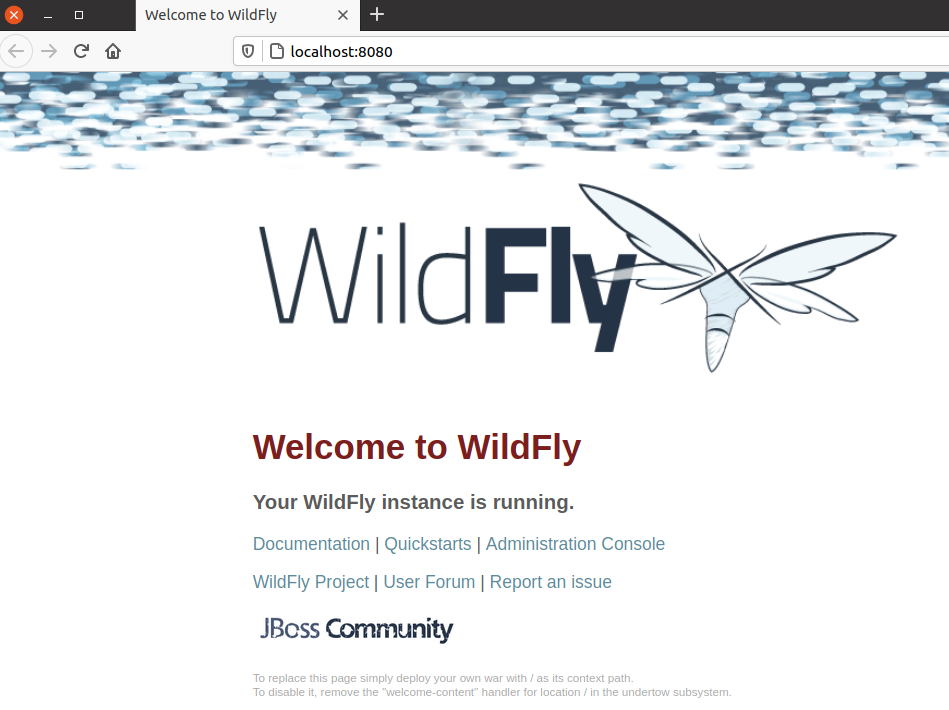
Wildfly Bootable JAR and Static Content
12 May 2021
- Summary
-
Web applications often serve static content alongside with dynamically generated HTML pages. If the static content is not hosted on a CDN, the application server should provide this kind of content, too. In this Blog post I'll show how to configure Wildfly Bootable JAR packaged servers to do this job.
Welcome Page
Users of JBoss/Wildfly know the welcome page, which is returned when navigating to the application server’s root.

The shown page is actually static content hosted in the file
$JBOSS_HOME/welcome-content/index.html. The last two lines displayed on the
page explain how to replace the content or get entirely rid of it. The
referenced configuration of the Undertow subsystem is part of the application
server’s standalone.xml (stripped down to the crucial parts):
<subsystem xmlns="urn:jboss:domain:undertow:3.0">
<buffer-cache name="default"/>
<server name="default-server">
<http-listener name="default" redirect-socket="https" socket-binding="http"/>
<host name="default-host" alias="localhost">
<location name="/" handler="welcome-content"/> (1)
...
</host>
</server>
...
<handlers>
<file name="welcome-content" path="${jboss.home.dir}/welcome-content"/> (2)
...
</handlers>
<filters>
...
</filters>
</subsystem>| 1 | The name of the location element defines the application server’s context,
i.e. how users can reach the content. |
| 2 | The referenced handler of type file specifies where in the file system the
content is hosted. |
After having a look at the configuration of the web container of Wildfly/JBoss, nothing other is the Undertow subsystem, we go into the details of the packaging as Bootable JAR.
Handler Configuration
Wildfly Bootable JAR packaged applications (Single Fat JAR) are deployed to the root context of the application server. Therefor there cannot be a welcome page at the same location. But it’s still possible to define static content handler on a different (no-root) context.
For demonstration purposes, the static content configuration has been added to
the
Jakarta MVC Demo application. So, if you prefer to study a complete example,
then grab the linked repository (code branch of Github repository of this
Blog project).
|
To demonstrate let’s first define some content to be published. These files go
into the project’s extra-content directory:

The index.html contains just a simple hello world page:
<!DOCTYPE html>
<html lang="en">
<head>
<meta charset="utf-8" />
<meta name="viewport" content="width=device-width, initial-scale=1.0" />
<title>Wildfly Web Content</title>
</head>
<body>
<h1>Hello world!</h1>
</body>
</html>Furthermore, the JBoss CLI to define the handler of static content is required.
The CLI scripts are hosted in scripts/setup.cli file:
/subsystem=undertow/configuration=handler/file=public-content:add(path="${jboss.home.dir}/web-root")
/subsystem=undertow/server=default-server/host=default-host/location="/public":add(handler="public-content")In this case, the location, from which users can fetch the static content, is
hosted below the public context path.
The extra-content and CLI scripts eventually need to be configured for the
Wildfly Bootable JAR packaging by the Maven plugin:
...
<build>
...
<plugins>
<plugin>
<groupId>org.wildfly.plugins</groupId>
<artifactId>wildfly-jar-maven-plugin</artifactId>
<configuration>
<feature-pack-location>wildfly@maven(org.jboss.universe:community-universe)#22.0.1.Final</feature-pack-location>
<layers>
<layer>web-server</layer>
<layer>jaxrs</layer>
<layer>management</layer>
</layers>
<excluded-layers>
<layer>deployment-scanner</layer>
</excluded-layers>
<cli-sessions>
<cli-session>
<script-files>
<script>scripts/setup.cli</script>
</script-files>
<resolve-expressions>true</resolve-expressions>
</cli-session>
</cli-sessions>
<extra-server-content-dirs>
<extra-server-content-dir>extra-content</extra-server-content-dir>
</extra-server-content-dirs>
</configuration>
<executions>
<execution>
<goals>
<goal>package</goal>
</goals>
</execution>
</executions>
</plugin>
</plugins>
</build>
...In order to test the setup, submit the following commands in a terminal:
# build and execute the application
$ mvn clean package
...
$ java -jar target/mvc-demo-bootable.jar
...
# while application is running in another terminal
$ curl localhost:8080/public/index.html
<!DOCTYPE html>
<html lang="en">
<head>
<meta charset="utf-8" />
<meta name="viewport" content="width=device-width, initial-scale=1.0" />
<title>Wildfly Web Content</title>
</head>
<body>
<h1>Hello world!</h1>
</body>
</html>
$Hollow JAR
Hollow JAR packaged applications do not contain/provide the welcome page,
although the application is typically not deployed to the root context (except
the application’s <finalName> is equal to ROOT).
To get the application packaged as Hollow JAR, i.e. a Bootable JAR for the plain vanilla application server and a WAR file containing the application, the Maven plugin configuration of the Wildfly Bootable JAR need to be amended with:
<hollowJar>true</hollowJar>
In addition, the file handler is configured with the location / as follows:
/subsystem=undertow/configuration=handler/file=public-content:add(path="${jboss.home.dir}/web-root")
/subsystem=undertow/server=default-server/host=default-host/location="/":add(handler="public-content")The user can now retrieve static content from the root context, just like the pre-defined welcome page of the classical Wildfly application server:
# build and execute the application
$ mvn clean package
...
$ java -jar target/mvc-demo-bootable.jar --deployment=target/mvc-demo.war
...
# while application is running in another terminal
$ curl localhost:8080/index.html
# or just: $ curl localhost:8080
<!DOCTYPE html>
<html lang="en">
<head>
<meta charset="utf-8" />
<meta name="viewport" content="width=device-width, initial-scale=1.0" />
<title>Wildfly Web Content</title>
</head>
<body>
<h1>Hello world!</h1>
</body>
</html>
$Summary
I already mentioned that the welcome page is not pre-configured for Bootable JAR packages Wildfly applications, because the root context is usually occupied by the application itself, at least for Single FAT JAR builds. Another reason might be, that Wildfly Bootable JAR follows the philosophy of creating a just-enough-application-server, i.e. containing just the features required by the application. If your application requires to serve static content, you have to define accordingly. However, as shown in this Blog Post, this is not a big deal.